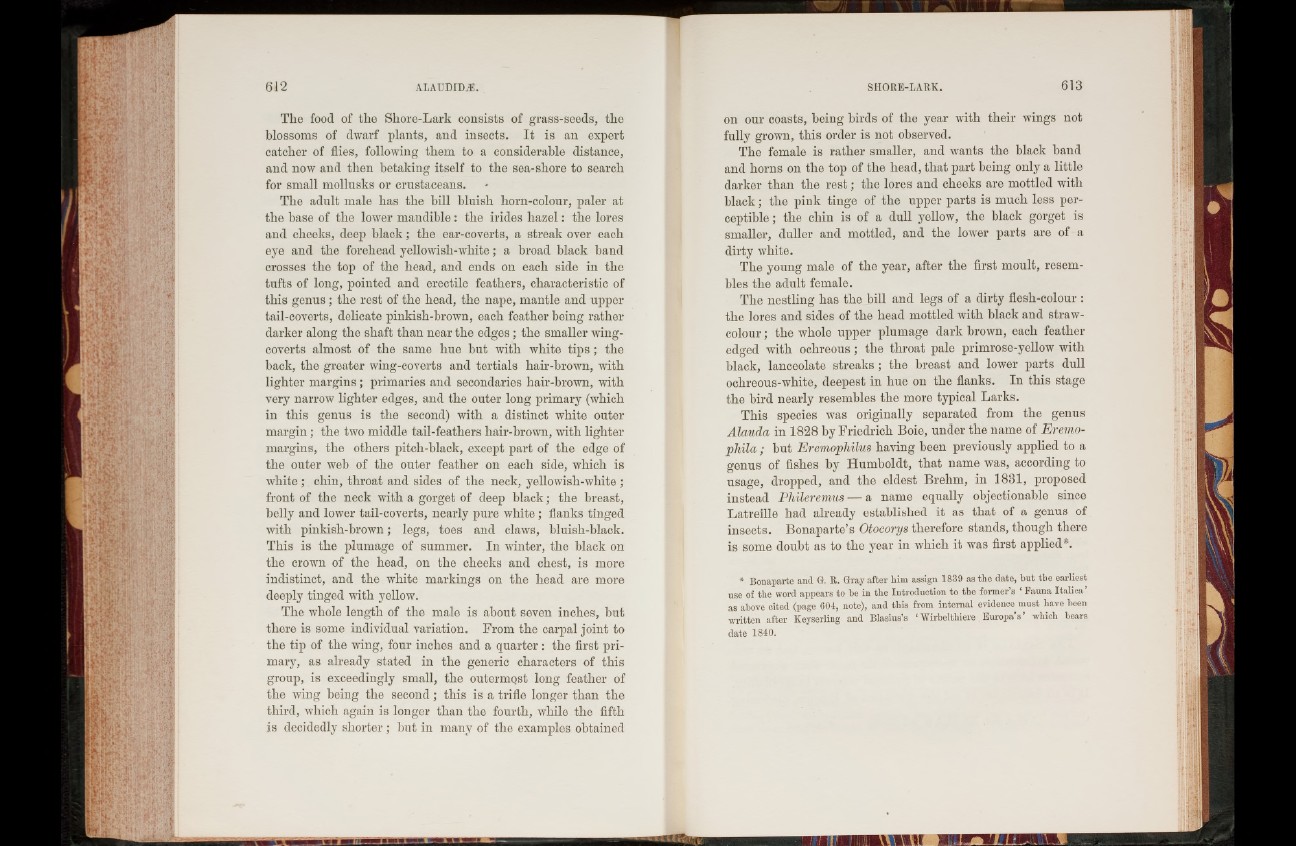
The food of the Shore-Lark consists of grass-seeds, the
blossoms of dwarf plants, and insects. I t is an expert
catcher of flies, following them to a considerable distance,
and now and then betaking itself to the sea-shore to search
for small mollusks or crustaceans.
The adult male has the bill bluish horn-colour, paler at
the base of the lower mandible : the irides h a z e l: the lores
and cheeks, deep black; the ear-coverts, a streak over each
eye and the forehead yellowish-white; a broad black band
crosses the top of the head, and ends on each side in the
tufts of long, pointed and erectile feathers, characteristic of
this genus; the rest of the head, the nape, mantle and upper
tail-coverts, delicate pinkish-brown, each feather being rather
darker along the shaft than near the edges ; the smaller wing-
coverts almost of the same hue but with white tips ; the
back, the greater wing-coverts and tertials hair-brown, with
lighter margins; primaries and secondaries hair-brown, with
very narrow lighter edges, and the outer long primary (which
in this genus is the second) with a distinct white outer
margin; the two middle tail-feathers hair-brown, with lighter
margins, the others pitch-black, except part of the edge of
the outer web of the outer feather on each side, which is
white ; chin, throat and sides of the neck, yellowish-white ;
front of the neck with a gorget of deep black; the breast,
belly and lower tail-coverts, nearly pure white; flanks tinged
with pinkish-brown; legs, toes and claws, bluisli-black.
This is the plumage of summer. In winter, the black on
the crown of the head, on the cheeks and chest, is more
indistinct, and the wdiite markings on the head are more
deeply tinged with yellow.
The whole length of the male is about seven inches, but
there is some individual variation. From the carpal joint to
the tip of the wing, four inches and a quarter: the first primary,
as already stated in the generic characters of this
group, is exceedingly small, the outermqst long feather of
the wing being the second; this is a trifle longer than the
third, which again is longer than the fourth, while the fifth
is decidedly shorter ; but in many of the examples obtained
on our coasts, being birds of the year with their wings not
fully grown, this order is not observed.
The female is rather smaller, and wants the black band
and horns on the top of the head, that part being only a little
darker than the re s t; the lores and cheeks are mottled with
black; the pink tinge of the upper parts is much less perceptible;
the chin is of a dull yellow, the black gorget is
smaller, duller and mottled, and the lower parts are of a
dirty -white.
The young male of the year, after the first moult, resembles
the adult female.
The nestling has the bill and legs of a dirty flesh-colour :
the lores and sides of the head mottled with black and straw-
colour ; the whole upper plumage dark brown, each feather
edged with ochreous; the throat pale primrose-yellow with
black, lanceolate streak s; the breast and lower parts dull
oclireous-white, deepest in hue on the flanks. In this stage
the bird nearly resembles the more typical Larks.
This species was originally separated from the genus
Alauda in 1828 by Friedrich Boie, under the name of Eremo-
phila ; but Eremophilus having been previously applied to a
genus of fishes by Humboldt, that name was, according to
usage, dropped, and the eldest Brehm, in 1831, proposed
instead Phileremus — a name equally objectionable since
Latreille had already established it as that of a genus of
insects. Bonaparte’s Otocorys therefore stands, though there
is some doubt as to the year in which it was first applied*.
* Bonaparte and G. R. Gray after him assign 1839 as the date, but the earliest
use of the word appears to be in the Introduction to the former’s ‘Fauna Italica’
as above cited (page 604, note), and this from internal evidence must have been
written after Keyserling and Blasius’s ‘ Wirbelthiere Europa s which bears
date 1840.